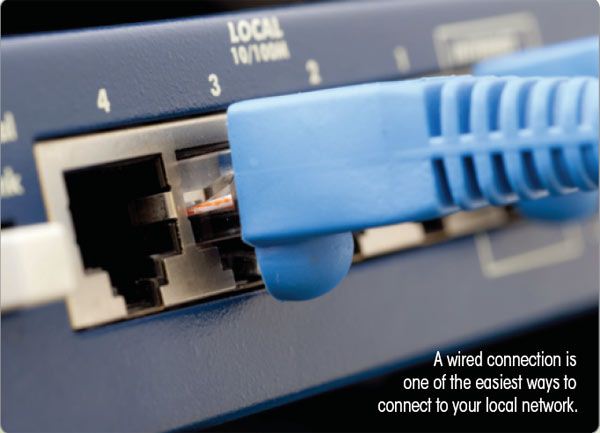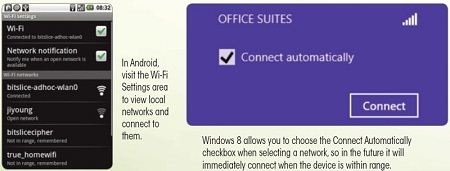Many of today’s devices rely heavily on access to your office network and the Internet. In this tutorial, we’ll show you how to connect devices to the company network.
We’ll be covering the following topics in this tutorial:
Laptops
Most laptops support wired and wireless connections. Creating a wired connection can be as simple as running an Ethernet cable from the router to the Ethernet port on the laptop. To connect to a local Wi-Fi network, you’ll need to know the SSID (Service Set Identifier), which is the name you gave the network when you set up the router. You’ll also need to know the security passcode.
To connect with a laptop running Windows 7, select the network icon in the Notification Area of the Taskbar (in the lower right corner of the screen). Under Wireless Network Connection, you should see the SSID for your office network, as well as the signal strength of the network. If your signal is weak or the SSID doesn’t appear, you may need to move closer to the wireless router for a more reliable, faster connection. Double-click the network you want to connect to and enter the password. When the laptop successfully connects, the icon in the Windows Taskbar will change from gray to white signal strength bars.

In Windows 8, move your mouse to the upper right corner of the screen (or swipe in from the right edge of the screen, if the PC has a touchscreen) to bring up the Charms Bar, which will appear on the right side of the screen. Select the Settings icon in the Charms Bar and choose the Wi-Fi icon. Select the Wi-Fi connection that lists the network SSID, and click Connect. Assuming that the network requires a password, enter the credentials and click OK.

Benefits Of A Wired Connection
• Connecting your desktop or laptop via Ethernet cable will provide an Internet signal that is faster (and more reliable) than a Wi-Fi connection.
• Connecting your computer to the network can be as easy as plugging the Ethernet cable into your router and your PC.
Benefits Of A Wireless Connection
• When you connect via Wi-Fi, you won’t have the hassle of being tethered to a particular location, so you can move between an office and board room while remaining connected to the Internet.
• You have the freedom to access the Internet in areas where wired connections aren’t available, such as a coffee shop or an airport.

Tablets
Most tablets can only connect to your office network wirelessly because they lack an Ethernet port. Although specific steps will vary by brand and model, you can generally reach the Wi-Fi feature by opening a Settings menu and finding the Wi-Fi or Wireless Networks tab.
Android
With a tablet that runs Android, bring up the app screen and select Settings. Choose Wireless & Networks and choose Wi-Fi Settings. Make sure the Wi-Fi is on (could be an on/off switch or you may need to check the Wi-Fi checkbox) and wait for the tablet to scan for available networks. Select the network to which you want to connect, and enter the security credentials. Select Show Password if you want to see the characters you enter. Tap Connect when you’ve entered the password, and you’ll see a Wi-Fi icon in the notification area.
iOS
With a tablet that runs iOS, click the Settings app and select Wi-Fi. Make sure that Wi-Fi is switched on, and look through the available networks for your preferred connection. Select the option you prefer and enter the password. Once connected, the Wi-Fi icon will turn blue.
Windows Phone
For smartphones that run Windows Phone 8, swipe in from the right side of the screen. Then, select Settings in the Charms Bar and choose the Wi-Fi icon. Tap the Wi-Fi connection you want to connect to and press Connect. Enter the password credentials and click OK. If your smartphone runs Windows Phone 7, select Start, flick left to see the App list, select Settings, and click Wi-Fi. Double-check that Wi-Fi networking is on and let the phone scan for available connections. Tap the network to which you want to connect, enter the security credentials, and click the checkbox.
Smartphones
Smartphones typically have mobile broadband and Wi-Fi connectivity. The mobile broadband connection is convenient, but the office Wi-Fi connection will provide faster, more reliable Web browsing and downloading.

Android
With an Android phone, open Settings and click Wireless & Networks. If Wi-Fi is not enabled, click the Wi-Fi tab to initialize a network scan. To see the available networks, click Wi-Fi Settings. Select your preferred network and scroll down to enter the security credentials. Once you’ve entered the password, click Connect. A Wi-Fi icon will appear in the notifications area once the smartphone is connected.
iOS
With a smartphone running iOS, click Settings, select Wi-Fi, and ensure that the Wi-Fi is enabled so that the smartphone can scan the area for Wi-Fi hotspots. Selecting a network will open an Enter Password screen where you can provide the Username and Password. When you’ve entered the credentials, click Accept and you should see blue bars next to the Wi-Fi icon.
E-readers
Many ebook readers have Wi-Fi connectivity. Some also support mobile broadband connections. Wi-Fi management tools are usually found in the e-reader’s settings under Wi-Fi or Wireless Networks. Connecting to an e-reader’s mobile broadband service is even easier, because the device usually connects automatically. If the e-reader isn’t connected, simply turn on the connection in the Settings menu.

Other Devices That Can Connect To Your Network
• Printers that can be shared with everyone connected to the network.
• NAS (Network Attached Storage) devices provide group file sharing.
• Smart Energy Management Technology offers remote-controlled thermostats and related features.
• HDTVs that include built-in online streaming apps.
Wi-Fi When You’re Out & About
● If you’re connecting outside of the office, such as at a local coffee shop, you may find that you don’t have access to the Internet (even though you’re connected to the shop’s Wi-Fi hotspot) until you open your device’s browser and accept the agreement that automatically appears.
Sometimes businesses charge for Wi-Fi access, so you may need to pay for a given amount of Internet time. A number of tablets are also capable of connecting to the Internet via builtin mobile broadband connections. These 3G- and 4G-enabled tablets are generally always connected, unless you set the tablet to Airplane mode (a mode in which all wireless connectivity is disabled).
 Dinesh Thakur holds an B.C.A, MCDBA, MCSD certifications. Dinesh authors the hugely popular
Dinesh Thakur holds an B.C.A, MCDBA, MCSD certifications. Dinesh authors the hugely popular